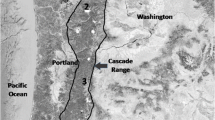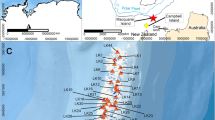Abstract
One hundred sixty-seven Prairie Pothole lakes, ponds and wetlands (largely lakes) previously analyzed chemically during the late 1960’s and early to mid-1970’s were resampled and reanalyzed in 2011–2012. The two sampling periods differed climatically. The earlier sampling took place during normal to slightly dry conditions, whereas the latter occurred during and immediately following exceptionally wet conditions. As reported previously in Mushet et al. (2015), the dominant effect was expansion of the area of these lakes and dilution of their major ions. However, within that context, there were significant differences in the evolutionary pathways of major ions. To establish these pathways, we employed the inverse modeling computer code NetpathXL. This code takes the initial and final lake composition and, using mass balance constrained by the composition of diluting waters, and input and output of phases, calculates plausible geochemical evolution pathways. Despite the fact that in most cases major ions decreased, a subset of the lakes had an increase in SO4 2−. This distinction is significant because SO4 2− is the dominant anion in a majority of Prairie Pothole Region wetlands and lakes. For lakes with decreasing SO4 2−, the proportion of original lake water required for mass balance was subordinate to rainwater and/or overland flow. In contrast, lakes with increasing SO4 2− between the two sampling episodes tended to be dominated by original lake water. This suite of lakes tended to be smaller and have lower initial SO4 2− concentrations such that inputs of sulfur from dissolution of the minerals gypsum or pyrite had a significant impact on the final sulfur concentration given the lower dilution factors. Thus, our study provides context for how Prairie Pothole Region water bodies evolve geochemically as climate changes. Because wetland geochemistry in turn controls the ecology of these water bodies, this research contributes to the prediction of the impact of climate change on this important complex of ecosystems.






Similar content being viewed by others
References
Arndt JL, Richardson JL (1989) Geochemistry of hydric soil salinity in a recharge-throughflow-discharge prairie-pothole wetland system. Soil Sci Soc Am J 53:848–855
Arndt J, Richardson J (1993) Temporal variations in the salinity of shallow groundwater from the periphery of some North Dakota wetlands (USA). J Hydrol 141:75–105
Bethke CM (2008) Geochemical and Biogeochemical Reaction Modeling, 2nd edn. Cambridge University Press, Cambridge England
Euliss NH, Wrubleski DA, Mushet DM (1999) Wetlands of the Prairie Pothole Region : Invertebrate Species Composition.Ecology, and Management. In: Batzer DP, Rader RB, WSA (eds) Invertebr. Freshw. Wetl. North Am. Ecol. Manag. John Wiley & Sons, New York, pp 471–514
Euliss NH, LaBaugh JW, Fredrickson LH et al (2004) The wetland continuum: a conceptual framework for interpreting biological studies. Wetlands 24:448–458. doi:10.1672/0277-5212(2004)024[0448:TWCACF]2.0.CO;2
Euliss NH, Mushet DM, Newton WE et al (2014) Placing prairie pothole wetlands along spatial and temporal continua to improve integration of wetland function in ecological investigations. J Hydrol 513:490–503. doi:10.1016/j.jhydrol.2014.04.006
Glynn P, Brown J (2011) Integrating field observations and inverse and forward modeling : application at a site with acidic, heavy-metal- contaminated groundwater. Geochemical Model. Groundwater, vadose Geotherm Syst
Goldhaber MB, Mills CT, Morrison JM et al (2014) Hydrogeochemistry of prairie pothole region wetlands: role of long-term critical zone processes. Chem Geol 387:170–183. doi:10.1016/j.chemgeo.2014.08.023
Heagle DJ, Hayashi M, van Der Kamp G (2007) Use of solute mass balance to quantify geochemical processes in a prairie recharge wetland. Wetlands 27:806–818
Heagle D, Hayashi M, Van Der Kamp G (2013) Surface–subsurface salinity distribution and exchange in a closed-basin prairie wetland. J Hydrol 478:1–14. doi:10.1016/j.jhydrol.2012.05.054
Hendry MJ, Cherry JA, Wallick EI (1986) Origin and distribution of sulfate in a fractured till in southern Alberta, Canada. Water Resour Res 22:45. doi:10.1029/WR022i001p00045
Jin L, Andrews DM, Holmes GH et al (2011) Opening the “black box”: water chemistry reveals hydrological controls on weathering in the Susquehanna shale hills critical zone observatory. Vadose Zone J 10:928. doi:10.2136/vzj2010.0133
Johnson WC, Millett BV, Gilmanov T et al (2005) Vulnerability of northern prairie wetlands to climate change. Bioscience 55:863. doi:10.1641/0006-3568(2005)055[0863:VONPWT]2.0.CO;2
Jokic A, Cutler JN, Ponomarenko E et al (2003) Organic carbon and sulphur compounds in wetland soils: insights on structure and transformation processes using K-edge XANES and NMR spectroscopy. Geochim Cosmochim Acta 67:2585–2597. doi:10.1016/S0016-7037(03)00101-7
LaBaugh, J.W., Mushet, D.M., Rosenberry, D.O., Euliss N.H. Jr., Goldhaber, M.B., Mills, C.T., Nelson, R.D., (in press) Changes in Pond Water Levels and Surface Extent Due to Climate Variability Alter Solute Sources to Closed-Basin Prairie-Pothole Wetland Ponds, 1972 to 2012; Wetlands; Published Online 15 “September, 2016; doi:10.1007/s13157-016-0808-x
Larson DR (1987) Major Glacial-Drift Aquifers in Burleigh, Emmons, and Kidder Counties, North Dakota N.D. Ground-Water Studies Number 93–Part II; N. D. State Water Commission
Last WM, Ginn FM (2005) Saline systems of the great plains of western Canada: an overview of the limnogeology and paleolimnology. Saline Syst 1:10. doi:10.1186/1746-1448-1-10
Leibowitz SG, Vining KC (2003) Temporal connectivity in a prairie pothole complex. Wetlands 23:13–25. doi:10.1672/0277-5212(2003)023[0013:TCIAPP]2.0.CO;2
Mushet, David M., Goldhaber, Martin B., Mills, Christopher T, McLean, Aparicio, Vanessa, M., McCleskey, Blaine, R, Holloway, JoAnn M., Stockwell, Craig A (2015) Chemical and Biotic Characteristics of Prairie Lakes and Large Wetlands in South-Central North Dakota — Effects of a Changing Climate; USGS Scientific Investigations Report 2015 – 5126.
Nachshon U, Ireson A, Van Der Kamp G, Wheater H (2013) Sulfate salt dynamics in the glaciated plains of North America. J Hydrol 499:188–199. doi:10.1016/j.jhydrol.2013.07.001
Plummer LN, Prestemon EC, Parkhurst DL (1994) An interactive code (NETPATH) for modeling net geochemical reactions along a flow path, version 2.0.
Richardson J, Arndt J, Freelland J (1994) Wetland soils of the prairie potholes. Adv Agron 52:121–171
Rosenberry DO, Winter TC (1997) Dynamics of water-table fluctuations in an upland between two prairie-pothole wetlands in North Dakota. J Hydrol 191:266–289. doi:10.1016/S0022-1694(96)03050-8
Rover J, Mushet DM (2015) Mapping wetlands and surface water in the prairie pothole region of North America. Remote sensing of Wetlands: Applications and Advances. Tiner RW, Lang MW and Klemas VV (eds.) CRC Press, Boca Raton, p 347–368
Rover J, Wright CK, Euliss NH et al (2011) Classifying the hydrologic function of prairie potholes with remote sensing and GIS. Wetlands 31:319–327. doi:10.1007/s13157-011-0146-y
Rozkowski A (1967) The origin of hydrochemical patterns in hummocky moraine. Can J Earth Sci 4:1065–1092
Skagen SK, Granfors DA, Melcher CP (2008) On determining the significance of ephemeral continental wetlands to North American migratory shorebirds. Auk 125:20–29. doi:10.1525/auk.2008.125.1.20
Stewart R, Kantrud H (1972) Vegetation of prairie potholes, North Dakota, in relation to quality of water and other environmental factors. USGS Professional Paper 585-D United States Government Printing Office
Swanson GA, Adomaitis VA, Lee FB, Serie JR, JAS (1984) Limnological conditions influencing duckling use of saline lakes in south-central North Dakota. J Wildl Manag 48:340–349
Swanson GA, Winter TA, Adomaitis VA, La Baugh JW (1988) Chemical Characteristics of Prairie Lakes in South-central North Dakota-Their Potential for Influencing Use by Fish and Wildlife; United State Department of Interior Fish and Wildlife Studies, Technical Report 18
van der Kamp G, Hayashi M (2009) Groundwater-wetland ecosystem interaction in the semiarid glaciated plains of North America. Hydrogeol J 17:203–214. doi:10.1007/s10040-008-0367-1
Vanstempvoort D, Hendry M, Schoenau J, Krouse H (1994) Sources and dynamics of sulfur in weathered till, western glaciated plains of North America. Chem Geol 111:35–56. doi:10.1016/0009-2541(94)90081-7
Winter TC (2003) Hydrological, Chemical, and Biological Characteristics of a Prairie Pothole Wetland Complex Under Highly Variable Climate Conditions- The Cottonwood Lake Area, East-Central North Dakota
Winter TC, Rosenberry DO (1998) Hydrology of CWL during drought and deluge. Clim Chang 40:189–209
Winters HA (1963) Geology and ground water resources of Stutsman County, North Dakota; part I. Geol Surv Bull 41:84
Zeng T, Arnold WA, Toner BM (2013) Microscale characterization of sulfur speciation in lake sediments. Environ Sci Technol 47:1287–96. doi:10.1021/es303914q
Acknowledgments
We wish to thank Chip Euliss and Tom Winter for both their pioneering research and patient tutelage on the Prairie Pothole science. We would also like to than the USGS Ecosystems Mission Area for support. Any use of trade, firm, or product names is for descriptive purposes only and does not imply endorsement by the U.S. Government.
Author information
Authors and Affiliations
Corresponding author
Rights and permissions
About this article
Cite this article
Goldhaber, M.B., Mills, C.T., Mushet, D.M. et al. Controls on the Geochemical Evolution of Prairie Pothole Region Lakes and Wetlands Over Decadal Time Scales. Wetlands 36 (Suppl 2), 255–272 (2016). https://doi.org/10.1007/s13157-016-0854-4
Received:
Accepted:
Published:
Issue Date:
DOI: https://doi.org/10.1007/s13157-016-0854-4




